Abstract
(1) Background: Condylar fracture healing pattern classification in children and adolescents is primarily based on the radiological assessment of condylar morphology; however, recent studies showed the presence of a poor correlation between post-treatment radiological findings and clinical temporomandibular joint (TMJ) dysfunction. The present case series aimed to correlate the condylar morphology, shape, and trabecular bone density with the skeletal asymmetry and the clinical recovery of two growing patients with unilateral condylar fractures undergoing orthopedic treatment with the Balters Bionator appliance. (2) Methods: Pre- and post-treatment (12 months) cone-beam computed tomography (CBCT) scans of two growing patients with unilateral condylar fracture were retrieved; both patients were treated with the Balters Bionator appliance for one year. Morphological evaluation of the condylar healing pattern was carried out on CBCT reconstructions of the mandible. Condylar remodeling and skeletal asymmetry were assessed through linear measurements performed on pre- and post-treatment CBCT scans; then, fractal analysis (FA) was employed to assess the condylar trabecular bone density on orthopantomographies (OPTs). Clinical and TMJ functional evaluation were retrieved from patients’ records from before and at the end of the treatment (12 months). (3) Results: Conservative treatment of condylar fractures in growing patients led to an increased bone density of the condylar heads, regardless of the post-treatment size and morphology of the injured condyles. Patient one presented an unchanged condylar morphology on the affected side, while patient two’s condyle was slightly spherical. The qualitative results were confirmed by quantitative measurements on CBCTs. The radiological healing patterns were associated with slightly different functional outcomes. Both patients also exhibited an improvement in skeletal asymmetry and TMJ function. (4) Conclusions: According to the findings in the present study, the condylar remodeling and bone apposition after conservative treatment of condylar fractures in growing patients can exhibit different radiological and functional outcomes. Indeed, an unchanged morphology of the condylar head is more likely to determine a physiological TMJ recovery.
1. Introduction
Condylar fractures represent one of the most frequent maxillofacial traumas in young people and adolescents. According to Kozakiewicz et al., approximately 45% of mandibular fractures involve the condyle, which is a critical anatomical structure as it serves as a primary growth center of the mandible [1].
In fact, in growing patients, injuries in this area can lead to several long-term complications, such as mandibular dysfunction, growth disturbances, and malocclusion [2].
The goal of treating mandibular condyle fractures is to restore joint functionality by achieving proper occlusion and restoring the integrity of bone and disc-ligament structures [3].
Treatment approaches are traditionally classified into two main categories: surgical-and non-surgical (conservative) treatment [4,5].
Conservative treatment is particularly recommended for growing patients due to the high remodeling potential of the condyle [6,7,8,9].
In fact, according to Reddy et al., conservative treatment of condylar fractures is particularly indicated in growing patients (≤16 years-old) when the condylar head and neck are either undisplaced, deviated, or displaced but not dislocated [10].
The conservative treatment involves both maxillomandibular fixation and the use of functional appliances, such as the Balters Bionator, which promote distraction of the condylar fragment and the presence of intermittent stimulation delivered through masticatory forces [11].
Additionally, conservative treatment helps to prevent scar formation, which can cause growth disturbances and facial asymmetry in growing patients [12,13,14,15].
The conservative treatment of condylar fractures has been widely endorsed by multiple studies, consistently producing positive functional outcomes in growing patients [11,16,17,18,19,20].
Different healing patterns of the condylar heads can result from condylar fractures [21,22].
In 2021, Du et al. introduced a 3D classification system for condylar fracture healing morphology in children and adolescents treated with maxillomandibular fixation (MMF) [9]. This classification system, which builds upon the nomenclature proposed by Neff [23] and modified by Hlawitschka [24], divides healing patterns into three main categories: unchanged pattern, spherical pattern and irregular pattern (further subdivided into three subtypes: triangle subtype, L-shaped subtype and Y-shaped) [9].
This 3D classification represents a significant advancement in the radiological analysis of condylar fractures, allowing for more precise evaluation of potential clinical and functional correlations with specific healing patterns [2].
However, a key limitation of this classification is its exclusive application to patients treated with MMF and splints; no study to date has applied this classification to patients treated with functional orthopedic appliances.
Moreover, current classifications primarily focus on the description of pre-treatment fracture morphology, without addressing the prognostic value of post-treatment healing patterns. Additionally, these systems largely rely on qualitative assessments, while quantitative evaluations of fracture healing remain underexplored.
The present study reported two growing patients undergoing conservative treatment with the Balters Bionator, with the aim of correlating radiological condylar remodeling with skeletal asymmetry, clinical and functional recovery, and condylar bone density. Indeed, the rationale of this study was to understand if Du’s classification of the condylar morphology through cone-beam computed tomography (CBCT) scans could be correlated with temporomandibular joint (TMJ) recovery of growing patients.
The present manuscript has been reported in agreement with the CARE guidelines [25] (Supplementary Table S1).
2. Materials and Methods
The present study is a single-centered retrospective report of two cases. The study protocol was conducted according to the Declaration of Helsinki and its future amendments [26], and all patients signed an informed consent form. The protocol was approved on May 2024 by the local ethical committee of the ‘Università Cattolica del Sacro Cuore’ (ID: 6708).
2.1. Participants
Two growing patients (<16 years old) affected by unilateral condylar fractures attending the Orthodontics Department of Fondazione Policlinico Universitario A. Gemelli-IRCSS between September 2022 and November 2023 were consecutively recruited. Both patients were treated conservatively with type II Balters Bionator appliance for one year. Both patients also presented pre- and post-treatment radiographic evaluations (OPT and maxillofacial CBCT). Patients who did not meet the above-mentioned criteria were not included in the present study.
The first patient was a 13-year-old boy, who experienced a unilateral right condylar fracture due to a traumatic accident during a bike ride. He presented a reduction in maximum mouth opening (MMO) and lateral excursion movements opposite to the injured side, along with algic symptoms.
The second patient was a 10-year-old girl, affected by a left unilateral condylar fracture due to a horse-riding accident. She did not present significant reduction in MMO but showed a reduction in lateral excursion movements opposite to the injured side, along with algic symptoms as well.
Both patients presented a type-III fracture of the condylar head according to Spiess and Schroll, with reduction of the ramal height [27,28], and a type B classification according to Neff and Hlawitschka [23,24].
2.2. Clinical Evaluation
Both patients performed a maxillofacial CBCT scan and were examined within five days after the injury. Prior to the clinical examination, and anamnestic data were carefully recorded, with special attention to the history of the trauma that led to the conditional fractures.
Both patients underwent maxillomandibular fixation (MMF) for 15 days (Figure 1a–f), in order to restore the condylar fragments to their anatomical position, leading to faster bone healing and enabling quicker functional recovery of the joint [29]. The maximum recommended duration for MMF is 15 days, to prevent complications such as condylar ankylosis [30].
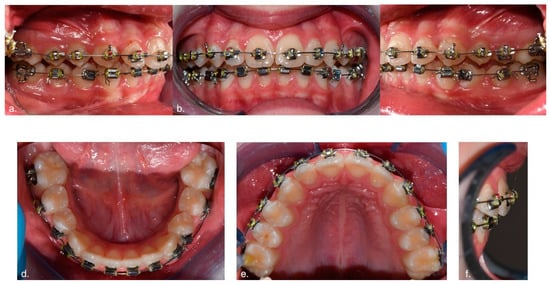
Figure 1.
(a–f) Maxillomandibular fixation (MMF) in patient two.
Due to the young age and the type of fracture, MMF was followed by a conservative treatment with type II Balters Bionator. The Balters Bionator appliance guides the mandible into protrusion and laterality opposite to the injured side, pulling the injured condyle away from the glenoid cavity, stimulating compensatory bone growth; meanwhile, the condyle regains proper mobility, averting the risk of ankylosis [13,31,32] (Figure 2a,b).
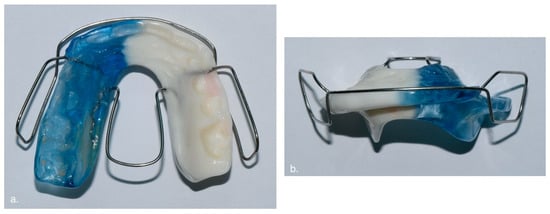
Figure 2.
(a,b) Customized type II Balters Bionator.
The appliance was worn by each patient for 12 months, with monthly follow-up visits [31].
2.3. Functional Evaluation
During the monthly check-ups, the following clinical parameters were assessed:
- Maximum mouth opening (MMO);
- Temporomandibular joint (TMJ) functional activity (lateral excursion movements);
- Midline deviation (MD);
- Presence/absence of articular noise (clicking, popping, crepitus);
- Presence/absence of algic symptoms.
MMO was defined as the greatest distance (mm) between the incisal edge of the maxillary central incisor and the incisal edge of the mandibular central incisor and was measured by using a modified Vernier caliper [33]. TMJ functional activity was measured as the greatest distance between the upper and lower incisal midlines during lateral (left and right) excursion movements [34] (Figure 3a–f). Midline deviation (MD) was defined as the greatest horizontal distance between the upper and the lower incisal midline and was measured with a Vernier caliper as well.
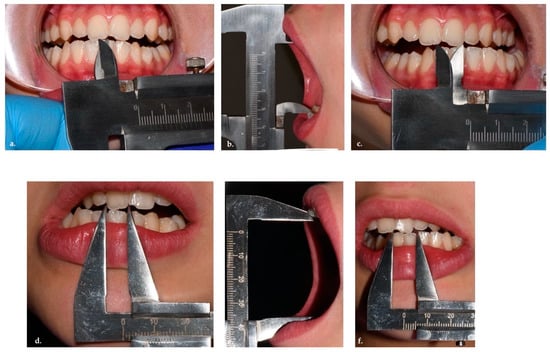
Figure 3.
(a–f) Functional clinical evaluation: MMO (b,e) and lateral excursion movements (a,c,d,f).
2.4. Radiological Evaluation and Measurements
2.4.1. CBCT Segmentation
CBCT scans in DICOM format were imported to AmiraTM (version 5.2.2; Mercury Computer Systems, Inc., Chelmsford, MA, USA). Amira software was used for the 3D reconstruction of the mandible (segmentation); using an appropriate grayscale threshold and after balancing the contrast, the mandibular bone was highlighted in all the sagittal slices of the CBCT.
Then, using the “magic wand” tool, the selected fragments were refined, thanks to an algorithm that controls the grey gradient between neighboring voxels.
All the slices were then interpolated, and a “mask” (a selected area on consecutive slices) of the mandible was generated. Then, the mask was converted into a 3D object [35].
2.4.2. D Qualitative Assessment
The condylar morphologies obtained from the 3D reconstructions on Amira were compared with the condylar healing patterns described by Du et al. [9].
3D reconstructions of the pre- and post-treatment mandibles were also imported on Geomagic Software (version 2014; 3D Systems, Rock Hill, SC, USA). The pre-treatment 3D model of the mandible acquired by CBCT was set as the “reference” (model on which the test model is superimposed) and the post-treatment model was set as the “test”.
Superimposition of the 3D models was achieved with point-to-point registration based on the selection of two bilateral landmarks present in anatomical areas not affected by the fracture (chin foramen, Spix spine).
Then, a colorimetric map was generated to outline the surface-to-surface discrepancy between the pre- and post-treatment 3D models.
Each color was associated with a deviation value: regions in “green” represented the area of maximum coincidence between the parts of the face (minimum deviation value), while regions in “blue” or “red”, as they progressed from the lightest to the darkest tonality, indicated inward and outward deviation of the overlapping part, respectively.
2.4.3. D Skeletal Asymmetry Assessment
Finally, the 3D analysis was used also to study the symmetry of the two patients.
Pre- and post-treatment 3D CT scans were imported to Mimics Medical 21.0 Software (Materialise, Leuven, Belgium, Europe), and a 3D mask was interpolated [36].
According to the analysis of Grummons et al. [37], modified by Janson [38], facial asymmetry was assessed and quantified by comparing the distances in mm of the injured side and the contralateral one.
The X-plane was used as a reference for the assessment of mandibular asymmetry on the frontal view; it was defined as the vertical plane passing through the upper and lower extremities of the crista galli [37,38].
Then, the following measurements were carried out (Figure 4):
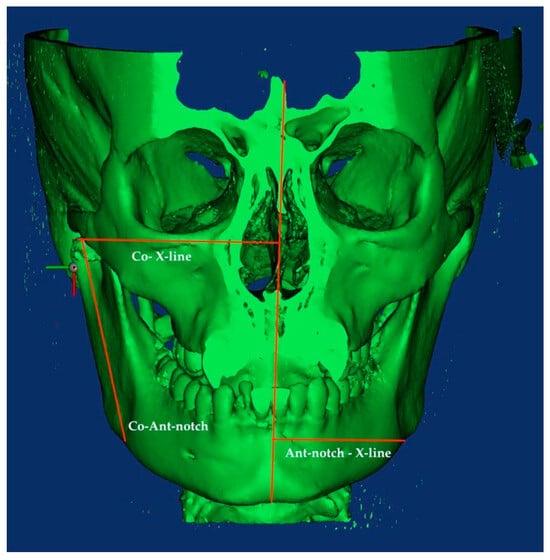
Figure 4.
Point-based assessment of facial asymmetry.
- Condylion—X-Line distance: horizontal distance between the X-Line and the upper point of the condylar head;
- Antegonial notch—X-Line distance: horizontal distance between the Antegonial notch and the X-Line;
- Antegonial-notch—Condylion distance: vertical distance between the upper point of the condylar head and the antegonial notch.
2.4.4. D Quantitative Assessment
Pre-treatment (immediate post-injury) and post-treatment (12 months post-therapy) radiographs (OPT and CBCT scans) from both patients were retrieved.
According to the study by Kahl-Nieke et al., the antero-posterior and medio-lateral diameter of the condylar heads were analyzed on Fiji (National Institutes of Health, Bethesda, Md) from the axial projection of the post-treatment CBCTs, at which the condylar heads showed the highest diameters (Figure 5a,b) [39].
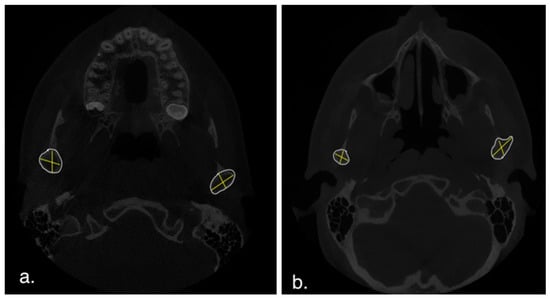
Figure 5.
(a,b) CBCT measurements at axial projection.
The affected site was used as the case, while the contralateral condyle served as the control [40].
It was decided to only include the post-treatment CBCTs (healthy side vs. injured side), since, at pre-treatment, both condylar heads were completely divided into two displaced fragments, making it difficult to measure the antero-posterior and medio-lateral diameters.
2.4.5. Fractal Analysis
Bone trabeculature from OPTs was analyzed with Fiji version 2.14 (National Institutes of Health, Bethesda, MD, USA) [39].
To quantify the interface between trabecular bone and medullary spaces, fractal analysis was carried out.
Fractal analysis, a mathematical method used to measure complex structures like trabecular bone, quantifies the interface between the cortical and medullary bone, calculating the FD (fractal dimension). A higher FD indicates a more complex structure [41,42].
The protocol, described by Cesur et al., involved the following steps [43]:
- Defining the region of interest (ROI: region of interest): condylar process, subcortical area of the condyle for OPTs (Figure 6);
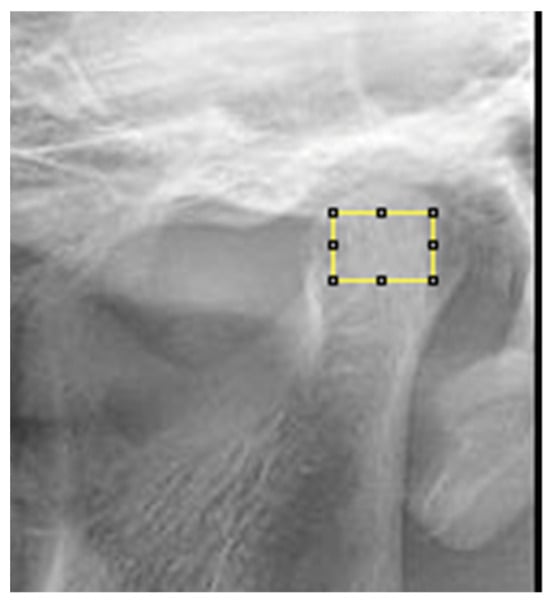 Figure 6. ROI selection on ImageJ.
Figure 6. ROI selection on ImageJ. - Application of Gaussian blurring, an image processing aimed at removing the “background noise” in the grayscale present in the radiograph, related to overlapping soft tissue or different thicknesses of bone tissue (Figure 7);
 Figure 7. (a–c) Gaussian blurring, image subtraction, and binary filters.
Figure 7. (a–c) Gaussian blurring, image subtraction, and binary filters. - Application of the binary filter to separate an object from the background (Figure 7);
- Erosion and dilation, two morphological operations that remove/add pixels to the contours of an object;
- Invert, a tool that inverts the tones (black and white) of an image, thus obtaining its negative, in photographic terms;
- Skeletonization, a tool that converts objects in the foreground of a binary image into a skeleton that preserves the original extent and interconnections;
- Finally, the fractal dimension (FD) was calculated.
2.5. Clinical-Functional Analysis
Clinical data from both patients’ medical record were retrieved. As previously mentioned, the functional-clinical evaluation included maximum mouth opening (MMO), temporomandibular joint (TMJ) functional activity (lateral excursion movements), midline deviation (MD), presence/absence of articular noise, and presence/absence of algic symptoms (Figure 3).
2.6. Statistical Analysis
The sample was presented in its demographic and clinical characteristics through descriptive statistical techniques. Quantitative variables were described as mean and standard deviation (SD). Radiographic indices were measured on both sides of the mandible; absolute values of the affected side and the healthy side was compared with each other through the following formula [44]:
Statistical analysis of the data was performed with R software version 4.2.0 (CRAN®, R Core 2022).
Two different operators carried out all measurements and the reproducibility of the method was measured with Cohen’s Kappa coefficient [45].
Moreover, the same operator repeated the measurements after 20 days.
3. Results
3.1. D Qualitative Assessment
According to the classification by Du et al. [9] on post-treatment records, patient one presented an unchanged morphology of the condylar head on the affected side: the fractured fragment merged with the remaining portion of the condylar head in its previous position, resulting in a regular morphology, without evident hyperplasia or reabsorption phenomena (Figure 8a–e).
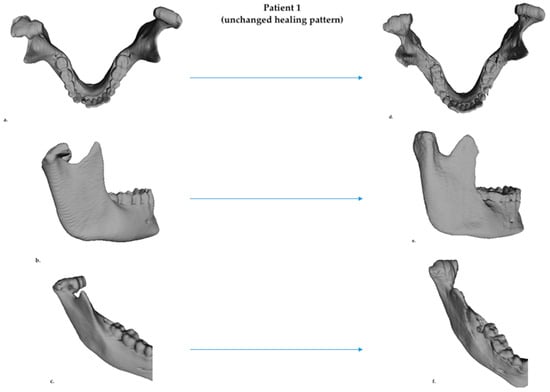
Figure 8.
(a–f) Patient one pre-and post-treatment condylar morphology (unchanged).
On the other hand, patient two’s affected condyle was spherical: the fractured segment merged with the condylar stump with a mild deviation so that the surface resulted more rounded-shaped (Figure 9a–e) [9].

Figure 9.
(a–f) Patient two pre- and post-treatment condylar morphology (spherical).
The 3D superimpositions highlighted and quantified pre- and post-treatment morphological changes (Figure 4 and Figure 5). Warm colors were associated with an outward displacement, meaning that, in the affected side, there was a greater volumetric increase compared to the healthy side. The greatest volumetric increase was found in the region of the affected condyle (Figure 9 and Figure 10).
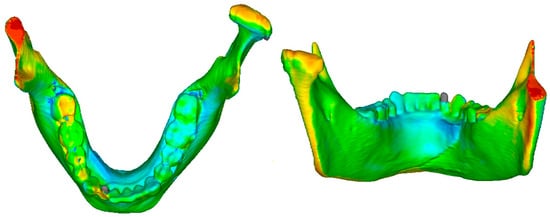
Figure 10.
Patient one’s STL superimpositions.
Moreover, the 3D superimposition of mandibular segmentations demonstrated that the transverse width of the mandible remained stable during treatment.
3.2. D Skeletal Asymmetry Assessment
According to the skeletal asymmetry assessment, both patients showed an improvement in the symmetry of the two hemi-mandibles. In particular, the greatest improvement was observed in the “Antegonial notch-X Line” distance, where the post-treatment values resulted almost identical. The results were confirmed with the post-treatment asymmetry index, which was lower for both patients concerning all measurements (Table 1).

Table 1.
3D skeletal asymmetry assessment; AI = asymmetry index.
3.3. D Quantitative Assessment
As for the quantitative measurement of post-treatment condylar heads, in patient one, the antero-posterior width of the injured side was almost identical to the healthy side (AI = 1.28%), while the medio-lateral width was 1 mm smaller than the contralateral side (AI = 1.2%). On the contrary, in patient two, both the antero-posterior (AI = 21.1%) and the medio-lateral (AI = 9.6%) width were about 3 mm higher than the healthy side (Table 2).

Table 2.
Radiographic assessment of condylar morphology; AI = asymmetry index.
3.4. Fractal Analysis
The obtained FD values of both patients showed a slight increase in terms of bone density and complexity of the injured condyles after orthopedic treatment; in fact, a higher FD value indicates a more complex bone structure [43,46]. On the contrary, the non-affected sites did not show significant changes (Table 3).

Table 3.
Condylar head density (FD) assessment.
3.5. Clinical-Functional Analysis
Patient one showed a higher improvement in both MMO and lateral excursion movements towards left, in which the affected condyle served as a rotating condyle (Table 4). On the other hand, patient two did not exhibit a reduction in MMO pre-treatment and did not show significant improvements in lateral excursion movements towards the right (Table 4).

Table 4.
Measurements of the patients’ functional activity before and after treatment with Bionator. * MMO = maximum mouth opening. ** MD = midline deviation.
A decrease in the MD (midline deviation) was detected for both patients, along with a reduction in algic symptoms as well. Finally, no articular noise was reported.
4. Discussion
The present case series showed that orthopedic treatment of unilateral condylar fractures in growing patients could achieve favorable clinical, radiological, and functional outcomes, despite the morphological and radiological differences that might occur between the healthy and the injured sides.
In the present study, in both patients, the affected side showed a volumetric improvement, as functional-orthopedic treatment of condylar fractures resulted in the repositioning of the condylar heads within the glenoyd fossa (Figure 10 and Figure 11). This is in accordance with Moss’ theory, according to which the condylar heads represent an important center of growth, being able to respond to external factors like muscular forces [47].

Figure 11.
Patient two’s STL superimpositions.
However, post-treatment qualitative analysis of the 3D models of the mandible showed that patient one presented an unchanged morphology of the condylar head, while patient two exhibited a more spherical healing pattern of the affected condyle, according to Du’s classification (Figure 8 and Figure 9) [9].
As for the skeletal asymmetry evaluation, both patients experienced a reduction in skeletal asymmetry after the treatment with the Balters Bionator (Table 1); specifically, patient one (with an unchanged healing pattern of the condylar head) showed a slightly greater improvement than patient two, as indicated by the AI (Table 1).
The quantitative measurements showed that the unchanged healing pattern presented a smaller discrepancy in the antero-posterior and medio-lateral condylar widths between healthy and the affected side, compared to patient two, with the spherical healing pattern (patient one AI = 1.28% and 1.2% vs. patient two AI = 21.1% and 9.6%, respectively) (Table 2).
Moreover, according to fractal analysis of the condylar trabecular bone on OPTs, both condyles showed an increased bone density on the affected side after conservative treatment (Table 3), regardless of the healing pattern. In fact, according to Cesur et al., orthopedic appliances lead to skeletal correction by modifying the shape and trabecular structure of the mandibular bone [43].
In the present case, the Bionator appliance provided the bone density (FD) of the condylar head through compensatory bony apposition pulling the condyle away from the glenoid cavity [13].
According to the clinical-functional assessment, patient one (unchanged healing pattern) showed a greater improvement in MMO and lateral excursion movements opposite to the injured side than patient two (spherical healing pattern) (Table 4). On the contrary, patient two did not present a significant reduction in MMO pre-treatment, while a slight reduction in lateral excursion movements opposite to the injured side persisted (Table 4). Moreover, both patients reported a reduction in the MD, which was higher for patient one.
Finally, none of the two patients presented articular noise of any kind, while showing a significant reduction in the algic symptoms (Table 4).
The present study has several strengths.
Firstly, this is the first study to correlate a three-dimensional classification of condylar morphology with CBCT scans of growing patients undergoing orthopedic treatment of condylar fractures.
In fact, the study of Du et al. provided a CBCT analysis of the condylar morphology in 96 patients treated with maxillofacial fixation, while other studies performed only assessments using OPT and NMR [48,49,50]. Still, in cases of patients suffering from trauma, a 3D evaluation such as CBCT is essential to assess the type of fracture in all its projections [2,51].
Secondly, this case series also introduced fractal analysis of the trabecular bone after unilateral condylar fractures, representing a starting point for quantifying the increase in bone density following closed treatment of condylar fractures [46]. Along with the introduction of fractal analysis, the present study also assessed the presence of skeletal asymmetry and morphological skeletal changes according to the 3D superimposition of mandibular STL files before and after therapy.
Thirdly, the present study provides a comprehensive evaluation of the radiological and clinical outcomes of the conservative treatment of condylar fractures and might contribute to the development of guidelines for classifying the prognosis of condylar fractures.
In fact, despite the very common nature of condylar fractures, the existing classifications are considered valid at an international level and primarily focus on the pre-treatment condition rather than the post-treatment prognostic evaluation [52].
The present study also assesses the relationship between radiological and clinical findings; in fact, patient one, who presented an unchanged morphology of the condylar head post-treatment, showed a reduced asymmetry and an overall better clinical condition than patient two (Table 1, Table 2, and Table 4).
Nevertheless, despite the morphological differences between the two healing patterns, orthopedic treatment resulted in physiological healing and remineralization of the condylar heads, without significant differences between the two patients (Table 3).
The present case series reported some limitations.
Firstly, this study is a retrospective case report, and, therefore, the sample size is too small to draw general conclusions. This could be due to the difficulty of recruiting a homogeneous sample, despite the very common nature of condylar fractures [21].
Moreover, our sample includes growing patients; therefore, continuous monitoring of the patients’ growth and a long-term assessment of skeletal symmetry are required.
Regarding patient-specific factors, future studies should investigate whether the coexistence of multiple maxillary fractures, unilateral or bilateral involvement, the site and displacement of the fracture, the status of dentition and occlusal guidance, disc integrity, and the patient’s age/sex may influence condylar growth and remodeling.
5. Conclusions
Conservative treatment of condylar fractures in growing patients leads to an increased bone density of the condylar heads, regardless of the post-treatment size and morphology of the injured condyles.
However, the condylar remodeling and bone apposition after closed treatment of condylar fractures in growing patients can result in different radiological and functional outcomes.
Indeed, according to the findings in the present study, an unchanged morphology of the condylar head is more likely to determine a physiological TMJ recovery.
In conclusion, a 3D qualitative and quantitative evaluation of condylar morphology, together with fractal analysis, skeletal asymmetry, and clinical outcomes, may be useful to develop guidelines concerning condylar fracture prognosis in growing patients.
Moreover, further prospective studies with a larger sample size in this field are required.
Supplementary Materials
The following supporting information can be downloaded at: https://www.mdpi.com/article/10.3390/app15084261/s1, Table S1: CARE guidelines; Video S1: post-treatment mouth opening in patients 1 and 2.
Author Contributions
Conceptualization, E.S. and I.C.; methodology, I.C. and A.S.; software, I.C. and A.S.; validation, M.C., P.G. and E.S.; formal analysis, I.C. and A.S.; investigation, E.S.; resources, M.C.; data curation, G.D.C.; writing—original draft preparation, I.C. and A.S.; writing—review and editing, E.S. and P.G.; visualization, I.C.; supervision, E.S.; project administration, M.C.; funding acquisition, G.D.C. All authors have read and agreed to the published version of the manuscript.
Funding
This research received no external funding.
Institutional Review Board Statement
This study was conducted in accordance with the Declaration of Helsinki and approved by the Institutional Review Board (or Ethics Committee) of Catholic University of the Sacred Heart (ID: 6708 approved 27 May 2024).
Informed Consent Statement
Informed consent was obtained from all subjects involved in the study.
Data Availability Statement
Authors agree to make data and materials supporting the results or analyses presented in the present paper available upon reasonable request.
Conflicts of Interest
The authors declare no conflicts of interest.
References
- Kozakiewicz, M.; Walczyk, A. Current Frequency of Mandibular Condylar Process Fractures. J. Clin. Med. 2023, 12, 1394. [Google Scholar] [CrossRef] [PubMed]
- Sahm, G.; Witt, E. Long-term results after childhood condylar fractures. A computer-tomographic study. Eur. J. Orthod. 1989, 11, 154–160. [Google Scholar] [CrossRef] [PubMed]
- Montazem, A.H.; Anastassov, G. Management of condylar fractures. Atlas Oral Maxillofac. Surg. Clin. N. Am. 2009, 17, 55–69. [Google Scholar] [CrossRef] [PubMed]
- Brandt, M.T.; Haug, R.H. Open versus closed reduction of adult mandibular condyle fractures: A review of the literature regarding the evolution of current thoughts on management. J. Oral Maxillofac. Surg. 2003, 61, 1324–1332. [Google Scholar] [CrossRef]
- Choi, K.Y.; Yang, J.-D.; Chung, H.-Y.; Cho, B.-C. Current Concepts in the Mandibular Condyle Fracture Management Part II: Open Reduction Versus Closed Reduction. Arch. Plast. Surg. 2012, 39, 301–308. [Google Scholar] [CrossRef]
- Wheeler, J.; Phillips, J. Pediatric facial fractures and potential long-term growth disturbances. Craniomaxillofac. Trauma Reconstr. 2011, 4, 43–52. [Google Scholar] [CrossRef]
- Medina, A.C. Functional appliance treatment for bilateral condylar fracture in a pediatric patient. Pediatr. Dent. 2009, 31, 432–437. [Google Scholar]
- Melsen, B.; Bjerregaard, J.; Bundgaard, M. The effect of treatment with functional appliance on a pathologic growth pattern of the condyle. Am. J. Orthod. Dentofac. Orthop. 1986, 90, 503–512. [Google Scholar] [CrossRef]
- Du, C.; Xu, B.; Zhu, Y.; Zhu, M. Radiographic evaluation in three dimensions of condylar fractures with closed treatment in children and adolescents. J. Craniomaxillofac. Surg. 2021, 49, 830–836. [Google Scholar] [CrossRef]
- Rutges, J.; Kruizinga, E.; Rosenberg, A.; Koole, R. Functional results after conservative treatment of fractures of the mandibular condyle. Br. J. Oral Maxillofac. Surg. 2007, 45, 30–34. [Google Scholar] [CrossRef]
- Reichenbach, E. Zur Diskusluxation und deren funktionskieferorthopädischer Behandlung. J. Orofac. Orthop./Fortschritte Kieferorthopädie 1958, 19, 44–48. [Google Scholar] [CrossRef]
- Assael, L.A. Open versus closed reduction of adult mandibular condyle fractures: An alternative interpretation of the evidence. J. Oral Maxillofac. Surg. 2003, 61, 1333–1339. [Google Scholar] [CrossRef] [PubMed]
- Tavares, C.A.; Allgayer, S. Conservative orthodontic treatment for a patient with a unilateral condylar fracture. Am. J. Orthod. Dentofac. Orthop. 2012, 141, e75–e84. [Google Scholar] [CrossRef] [PubMed]
- Hennig, C.L.; Krause, F.; Nitzsche, A.; Tolksdorf, K.; Reise, M.; Kranz, S.; Dederichs, M.; Schultze-Mosgau, S.; Jacobs, C. Functional Orthodontic Therapy for Mandibular Condyle Fracture: A Systematic Review. Medicina 2024, 60, 1336. [Google Scholar] [CrossRef]
- Azzi, L.; Moretto, P.; Vinci, R.; Croveri, F.; Boggio, A.; Silvestre-Rangil, J.; Tettamanti, L.; Tagliabue, A.; Passi, A. Human beta2-defensin in oral lichen planus expresses the degree of inflammation. J. Biol. Regul. Homeost. Agents 2017, 31 (Suppl. S1), 77–87. [Google Scholar]
- Schienbein, H. Treatment of temporomandibular fractures with an activator (II). Quintessence Int. Dent. Dig. 1977, 8, 9–18. [Google Scholar]
- Kirchner, L. Die funktionskieferorthopädische Behandlung der Kiefergelenkfrakturen. J. Orofac. Orthop. 1958, 19, 60–68. [Google Scholar] [CrossRef]
- Steinhardt, G. Behandlung der Frakturen des Kieferbereiches im Kindesalter. Zahnarztl Mitt. 1979, 69, 34–40. [Google Scholar]
- Hirschfelder, U. Eine klinische und computertomographische Untersuchung. Fortschritte Der Kieferorthopädie 1987, 48, 504–515. [Google Scholar] [CrossRef]
- Lajolo, C.; Tranfa, M.; Patini, R.; Fiorino, A.; Musarra, T.; Boniello, R.; Moro, A. Clinical Evaluation of the Optical Filter for Autofluorescence Glasses for Oral Cancer Curing Light Exposed (GOCCLES((R))) in the Management of Potentially Premalignant Disorders: A Retrospective Study. Int. J. Environ. Res. Public Health 2022, 19, 5579. [Google Scholar]
- Sabbagh, H.; Nikolova, T.; Kakoschke, S.C.; Wichelhaus, A.; Kakoschke, T.K. Functional Orthodontic Treatment of Mandibular Condyle Fractures in Children and Adolescent Patients: An MRI Follow-Up. Life 2022, 12, 1596. [Google Scholar] [CrossRef] [PubMed]
- Zhou, H.H.; Lv, K.; Yang, R.-T.; Li, Z.; Li, Z.-B. Extracapsular Condylar Fractures Treated Conservatively in Children: Mechanism of Bone Remodelling. J. Craniofac. Surg. 2021, 32, 1440–1444. [Google Scholar] [CrossRef] [PubMed]
- Neff, A.; Kolk, A.; Deppe, H.; Horch, H.H. New aspects for indications of surgical management of intra-articular and high temporomandibular dislocation fractures. Mund-Kiefer-Und Gesichtschirurgie MKG 1999, 3, 24–29. [Google Scholar] [CrossRef] [PubMed]
- Hlawitschka, M.; Eckelt, U. Assessment of patients treated for intracapsular fractures of the mandibular condyle by closed techniques. J. Oral Maxillofac. Surg. 2002, 60, 784–791; discussion 792. [Google Scholar] [CrossRef]
- Riley, D.S.; Barber, M.S.; Kienle, G.S.; Aronson, J.K.; von Schoen-Angerer, T.; Tugwell, P.; Kiene, H.; Helfand, M.; Altman, D.G.; Sox, H.; et al. CARE guidelines for case reports: Explanation and elaboration document. J. Clin. Epidemiol. 2017, 89, 218–235. [Google Scholar] [CrossRef]
- World Medical, A. World Medical Association Declaration of Helsinki: Ethical principles for medical research involving human subjects. JAMA 2013, 310, 2191–2194. [Google Scholar] [CrossRef]
- Loukota, R.A.; Neff, A.; Rasse, M. Nomenclature/classification of fractures of the mandibular condylar head. Br. J. Oral Maxillofac. Surg. 2010, 48, 477–478. [Google Scholar] [CrossRef]
- Powers, D.B. Classification of Mandibular Condylar Fractures. Atlas Oral Maxillofac. Surg. Clin. N. Am. 2017, 25, 1–10. [Google Scholar] [CrossRef]
- Long, X. The relationship between temporomandibular joint ankylosis and condylar fractures. Chin. J. Dent. Res. 2012, 15, 17–20. [Google Scholar]
- Hirjak, D.; Machon, V.; Beno, M.; Galis, B.; Kupcova, I. Surgical treatment of condylar head fractures, the way to minimize the postraumatic TMJ ankylosis. Bratisl. Lek. Listy 2017, 118, 17–22. [Google Scholar] [CrossRef]
- Ma, X.; Zhang, X.; Liu, X.; Hou, C.; Hou, W. A case report of conservative treatment of sagittal condylar fracture in a child: 13 years of follow up. Chin. J. Stomatol. 2015, 50, 217–219. [Google Scholar]
- Naeije, M.; Hansson, T.L. Short-term effect of the stabilization appliance on masticatory muscle activity in myogenous craniomandibular disorder patients. J. Craniomandib. Disord. 1991, 5, 245–250. [Google Scholar] [PubMed]
- Fatima, J.; Kaul, R.; Jain, P.; Saha, S.; Halder, S.; Sarkar, S. Clinical Measurement of Maximum Mouth Opening in Children of Kolkata and Its Relation with Different Facial Types. J. Clin. Diagn. Res. 2016, 10, ZC01. [Google Scholar] [CrossRef] [PubMed]
- Gomes, C.A.F.d.P.; Dibai-Filho, A.V.; da Silva, J.R.; de Oliveira, P.M.; Politti, F.; Biasotto-Gonzalez, D.A. Correlation between severity of temporomandibular disorder and mandibular range of motion. J. Bodyw. Mov. Ther. 2014, 18, 306–310. [Google Scholar]
- Staderini, E.; Guglielmi, F.; Cornelis, M.A.; Cattaneo, P.M. Three-dimensional prediction of roots position through cone-beam computed tomography scans-digital model superimposition: A novel method. Orthod. Craniofac. Res. 2019, 22, 16–23. [Google Scholar] [CrossRef]
- Li, J.; Zhang, H.; Yin, P.; Su, X.; Zhao, Z.; Zhou, J.; Li, C.; Li, Z.; Zhang, L.; Tang, P. A New Measurement Technique of the Characteristics of Nutrient Artery Canals in Tibias Using Materialise’s Interactive Medical Image Control System Software. BioMed Res. Int. 2015, 2015, 171672. [Google Scholar] [CrossRef]
- Grummons, D.C.; van de Coppello, M.A.K. A frontal asymmetry analysis. J. Clin. Orthod. 1987, 21, 448–465. [Google Scholar]
- Janson, G.R.; Metaxas, A.; Woodside, D.G.; de Freitas, M.R.; Pinzan, A. Three-dimensional evaluation of skeletal and dental asymmetries in Class II subdivision malocclusions. Am. J. Orthod. Dentofac. Orthop. 2001, 119, 406–418. [Google Scholar] [CrossRef]
- Schindelin, J.; Arganda-Carreras, I.; Frise, E.; Kaynig, V.; Longair, M.; Pietzsch, T.; Preibisch, S.; Rueden, C.; Saalfeld, S.; Schmid, B.; et al. Fiji: An open-source platform for biological-image analysis. Nat. Methods 2012, 9, 676–682. [Google Scholar] [CrossRef]
- Kahl-Nieke, B.; Fischbach, R.; Gerlach, K.L. CT analysis of temporomandibular joint state in children 5 years after functional treatment of condylar fractures. Int. J. Oral Maxillofac. Surg. 1994, 23 Pt 1, 332–337. [Google Scholar] [CrossRef]
- Demiralp, K.O.; Kurşun-Çakmak, E.Ş.; Bayrak, S.; Akbulut, N.; Atakan, C.; Orhan, K. Trabecular structure designation using fractal analysis technique on panoramic radiographs of patients with bisphosphonate intake: A preliminary study. Oral Radiol. 2019, 35, 23–28. [Google Scholar] [CrossRef] [PubMed]
- Kursun-Cakmak, E.S.; Bayrak, S. Comparison of fractal dimension analysis and panoramic-based radiomorphometric indices in the assessment of mandibular bone changes in patients with type 1 and type 2 diabetes mellitus. Oral Surg. Oral Med. Oral Pathol. Oral Radiol. 2018, 126, 184–191. [Google Scholar] [CrossRef] [PubMed]
- Cesur, E.; Bayrak, S.; Kursun-Çakmak, E.Ş.; Arslan, C.; Köklü, A.; Orhan, K. Evaluating the effects of functional orthodontic treatment on mandibular osseous structure using fractal dimension analysis of dental panoramic radiographs. Angle Orthod. 2020, 90, 783–793. [Google Scholar] [CrossRef]
- Turker, G.; Yasar, M.O. Evaluation of associations between condylar morphology, ramus height, and mandibular plane angle in various vertical skeletal patterns: A digital radiographic study. BMC Oral Health 2022, 22, 330. [Google Scholar]
- Wieckowska, B.; Kubiak, K.B.; Jóźwiak, P.; Moryson, W.; Stawińska-Witoszyńska, B. Cohen’s Kappa Coefficient as a Measure to Assess Classification Improvement following the Addition of a New Marker to a Regression Model. Int. J. Environ. Res. Public Health 2022, 19, 10213. [Google Scholar] [CrossRef]
- Arslan, S.; Korkmaz, Y.N.; Buyuk, S.K.; Tekin, B. Effects of reverse headgear therapy on mandibular trabecular structure: A fractal analysis study. Orthod. Craniofac. Res. 2022, 25, 562–568. [Google Scholar] [CrossRef]
- Moss, M.L. The functional matrix hypothesis revisited. 1. The role of mechanotransduction. Am. J. Orthod. Dentofac. Orthop. 1997, 112, 8–11. [Google Scholar] [CrossRef]
- Zhao, Y.M.; Yang, J.; Bai, R.-C.; Ge, L.-H.; Zhang, Y. A retrospective study of using removable occlusal splint in the treatment of condylar fracture in children. J. Craniomaxillofac. Surg. 2014, 42, 1078–1082. [Google Scholar] [CrossRef]
- Zheng, J.; Zhang, S.; Yang, C.; Abdelrehem, A.; He, D.; Chiu, H. Assessment of magnetic resonance images of displacement of the disc of the temporomandibular joint in different types of condylar fracture. Br. J. Oral Maxillofac. Surg. 2016, 54, 74–79. [Google Scholar] [CrossRef]
- Yu, Y.H.; Wang, M.H.; Zhang, S.Y.; Fang, Y.M.; Zhu, X.H.; Pan, L.L.; Yang, C. Magnetic resonance imaging assessment of temporomandibular joint soft tissue injuries of intracapsular condylar fracture. Br. J. Oral Maxillofac. Surg. 2013, 51, 133–137. [Google Scholar] [CrossRef]
- Choi, J.; Oh, N.; Kim, I.K. A follow-up study of condyle fracture in children. Int. J. Oral Maxillofac. Surg. 2005, 34, 851–858. [Google Scholar] [CrossRef] [PubMed]
- Neff, A.; Cornelius, C.-P.; Rasse, M.; Torre, D.; Audigé, L. The Comprehensive AOCMF Classification System: Condylar Process Fractures-Level 3 Tutorial. Craniomaxillofac Trauma Reconstr. 2014, 7 (Suppl. S1), S044–S058. [Google Scholar] [CrossRef]
Disclaimer/Publisher’s Note: The statements, opinions and data contained in all publications are solely those of the individual author(s) and contributor(s) and not of MDPI and/or the editor(s). MDPI and/or the editor(s) disclaim responsibility for any injury to people or property resulting from any ideas, methods, instructions or products referred to in the content. |
© 2025 by the authors. Licensee MDPI, Basel, Switzerland. This article is an open access article distributed under the terms and conditions of the Creative Commons Attribution (CC BY) license (https://creativecommons.org/licenses/by/4.0/).